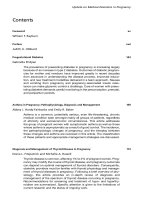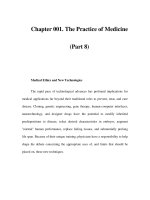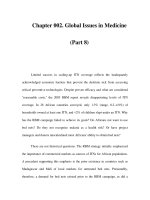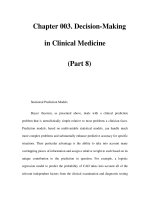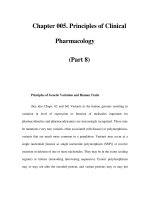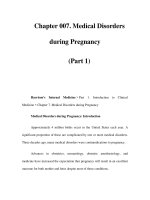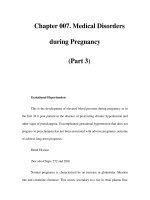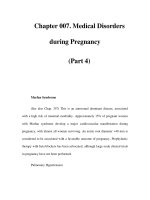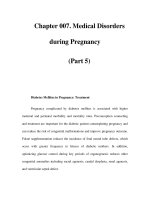Chapter 007. Medical Disorders during Pregnancy (Part 8) doc
Bạn đang xem bản rút gọn của tài liệu. Xem và tải ngay bản đầy đủ của tài liệu tại đây (14.32 KB, 6 trang )
Chapter 007. Medical Disorders
during Pregnancy
(Part 8)
Rubella
(See also Chap. 186) Rubella virus is a known teratogen; first-trimester
rubella carries a high risk of fetal anomalies, though the risk decreases
significantly later in pregnancy. Congenital rubella may be diagnosed by
percutaneous umbilical blood sampling with the detection of IgM antibodies in
fetal blood. All pregnant women should be screened for their immune status to
rubella. Indeed, all women of childbearing age, regardless of pregnancy status,
should have their immune status for rubella verified and be immunized if
necessary. The incidence of congenital rubella in the United States is extremely
low.
Herpesvirus
(See also Chap. 172) The acquisition of genital herpes during pregnancy is
associated with spontaneous abortion, prematurity, and congenital and neonatal
herpes. A recent cohort study of pregnant women without evidence of previous
herpes infection demonstrated that ~2% of the women acquired a new herpes
infection during the pregnancy. Approximately 60% of the newly infected women
had no clinical symptoms. Infection occurred equally in all three trimesters. If
herpes seroconversion occurred early in pregnancy, the risk of transmission to the
newborn was very low. In women who acquired genital herpes shortly before
delivery, the risk of transmission was high. The risk of active genital herpes
lesions at term can be reduced by prescribing acyclovir for the last 4 weeks of
pregnancy to women who have had their first episode of genital herpes during the
pregnancy.
Herpesvirus infection in the newborn can be devastating. Disseminated
neonatal herpes carries with it high mortality and morbidity rates from CNS
involvement. It is recommended that pregnant women with active genital herpes
lesions at the time of presentation in labor be delivered by cesarean section.
Parvovirus
(See also Chap. 177) Parvovirus infection (human parvovirus B19) may
occur during pregnancy. It rarely causes sequelae, but susceptible women infected
during pregnancy may be at risk for fetal hydrops secondary to erythroid aplasia
and profound anemia.
HIV Infection
(See also Chap. 182) The predominant cause of HIV infection in children is
transmission of the virus from the mother to the newborn during the perinatal
period. Exposures, which increase the risk of mother-to-child transmission,
include vaginal delivery, preterm delivery, trauma to the fetal skin, and maternal
bleeding. Additionally, recent infection with high maternal viral load, low
maternal CD4+ T cell count, prolonged labor, prolonged length of membrane
rupture, and the presence of other genital tract infections, such as syphilis or
herpes, increase the risk of transmission. Breast-feeding may also transmit HIV to
the newborn and is therefore contraindicated in most developed countries for HIV-
infected mothers. There is no clear evidence to suggest that the course of HIV
disease is altered by pregnancy. There is also no clear evidence to suggest that
uncomplicated HIV disease adversely impacts pregnancy other than by its inherent
infection risk.
HIV Infection in Pregnancy: Treatment
The majority of cases of mother-to-child (vertical) transmission of HIV-1
occur during the intrapartum period. Mechanisms of vertical transmission include
infection after rupture of the membranes and direct contact of the fetus with
infected secretions or blood from the maternal genital tract. Zidovudine (ZDV)
administered during pregnancy and labor and to the newborn reduces the risk of
vertical transmission by 70%. Cesarean section is associated with additional risk
reduction compared to vaginal delivery, especially in women with a viral load
>1000 copies/mL. Regardless of the mode of delivery, intrapartum ZDV should be
provided.
Summary
Maternal mortality has decreased steadily during the past 70 years. The
maternal death rate has decreased from nearly 600/100,000 live births in 1935 to
8/100,00 live births in 2002. The most common causes of maternal death in the
United States today are, in decreasing order of frequency, pulmonary embolism,
obstetric hemorrhage, hypertension, sepsis, cardiovascular conditions including
peripartum cardiomyopathy, and ectopic pregnancy. With improved diagnostic
and therapeutic modalities as well as with advances in the treatment of infertility,
more patients with medical complications will be seeking, and be in need of,
complex obstetric care. Improving outcome of pregnancy in these women will be
best obtained by assembling a team of internists, specialists in maternal-fetal
medicine (high-risk obstetrics), and anesthesiologists to counsel these patients
about the risks of pregnancy and to plan their treatment prior to conception. The
importance of preconception counseling cannot be overstated. It is the
responsibility of all physicians caring for women in the reproductive age group to
assess their patient's reproductive plans as part of their overall health evaluation.
Further Readings
Alexander EK
et al: Timing and magnitude of increases in levothyroxine
requirements during pregnancy in women with hypo
thyroidism. N Engl J Med
351:292, 2005
Bates SM
et al: Use of antithrombotic agents during pregnancy: The
Seventh ACCP Conference on antithrombotic and thrombolytic therapy. Chest
126:627S, 2004
Buchanan TA, Xiang AH: Gestational diabetes mellitus. J C
lin Invest
115:485, 2005 [PMID: 15765129]
Crowther CA et al: Effect of treatment of gestational diabetes mellitus on
pregnancy outcomes. N Engl J Med 352:2477, 2005 [PMID: 15951574]
Deneux-Tharaux C et al: Underreporting of pregnancy-related mortality
in
the United States and Europe. Obstet Gynecol 106:684, 2005 [PMID: 16199622]
Kaaja RJ, Greer IA: Manifestations of chronic disease during pregnancy.
JAMA 294:2751, 2005 [PMID: 16333011]
Levine RJ: Circulating angiogenic factors and the risk of preecl
ampsia. N
Engl J Med 350:672, 2004 [PMID: 14764923]
Magee LA et al: Hydralazine for treatment of severe hypertension in
pregnancy: Meta-analysis. BMJ 327:955, 2003 [PMID: 14576246]
Sibai BM: Chronic hypertension in pregnancy. Obstet Gynecol 100:369,
2002 [PMID: 12151166]
The Magpie Trial Collaborative Group: Do women with preeclampsia, and
their babies, benefit from magnesium sulfate? The Magpie Trial: A randomised
placebo-controlled trial. Lancet 359:1877, 2002
